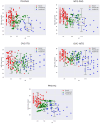The features analysis of hemoglobin expression on visual information transmission pathway in early stage of Alzheimer's disease
- PMID: 38972885
- PMCID: PMC11228039
- DOI: 10.1038/s41598-024-64099-0
The features analysis of hemoglobin expression on visual information transmission pathway in early stage of Alzheimer's disease
Abstract
Alzheimer's disease (AD) is a neurodegenerative disorder characterized primarily by cognitive impairment. The motivation of this paper is to explore the impact of the visual information transmission pathway (V-H pathway) on AD, and the following feature were observed: Hemoglobin expression on the V-H pathway becomes dysregulated as AD occurs so as to the pathway becomes dysfunctional. According to the feature, the following conclusion was proposed: As AD occurs, abnormal tau proteins penetrate bloodstream and arrive at the brain regions of the pathway. Then the tau proteins or other toxic substances attack hemoglobin molecules. Under the attack, hemoglobin expression becomes more dysregulated. The dysfunction of V-H pathway has an impact on early symptoms of AD, such as spatial recognition disorder and face recognition disorder.
Keywords: Alzheimer’s disease; Hemoglobin; Visual information transmission pathway.
© 2024. The Author(s).
Conflict of interest statement
The authors declare no competing interests.
Figures



















Similar articles
-
Proteomic signatures of brain regions affected by tau pathology in early and late stages of Alzheimer's disease.Neurobiol Dis. 2019 Oct;130:104509. doi: 10.1016/j.nbd.2019.104509. Epub 2019 Jun 15. Neurobiol Dis. 2019. PMID: 31207390
-
Tau accumulation in the retina promotes early neuronal dysfunction and precedes brain pathology in a mouse model of Alzheimer's disease.Mol Neurodegener. 2017 Aug 3;12(1):58. doi: 10.1186/s13024-017-0199-3. Mol Neurodegener. 2017. PMID: 28774322 Free PMC article.
-
Proteins recruited to exosomes by tau overexpression implicate novel cellular mechanisms linking tau secretion with Alzheimer's disease.J Alzheimers Dis. 2014;40 Suppl 1(Suppl 1):S47-70. doi: 10.3233/JAD-132135. J Alzheimers Dis. 2014. PMID: 24718102 Free PMC article.
-
Impacts of DNA methylation on Tau protein related genes in the brains of patients with Alzheimer's disease.Neurosci Lett. 2021 Oct 15;763:136196. doi: 10.1016/j.neulet.2021.136196. Epub 2021 Aug 23. Neurosci Lett. 2021. PMID: 34437990 Review.
-
Tau in Alzheimer's Disease: Mechanisms and Therapeutic Strategies.Curr Alzheimer Res. 2018;15(3):283-300. doi: 10.2174/1567205014666170417111859. Curr Alzheimer Res. 2018. PMID: 28413986 Review.
Cited by
-
Transcriptome analysis of early- and late-onset Alzheimer's disease in Korean cohorts.Alzheimers Dement. 2025 Feb;21(2):e14563. doi: 10.1002/alz.14563. Alzheimers Dement. 2025. PMID: 39935412 Free PMC article.
References
MeSH terms
Substances
LinkOut - more resources
Full Text Sources
Medical
Research Materials

